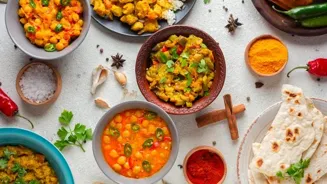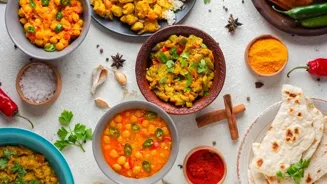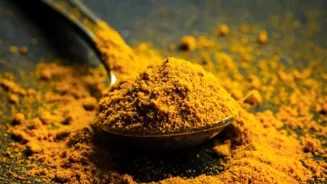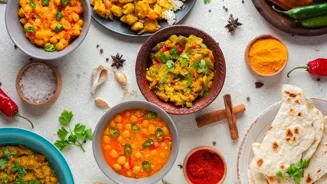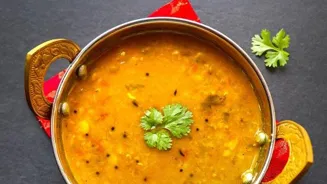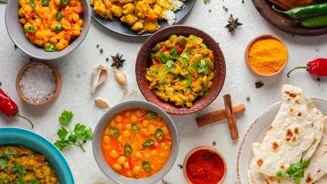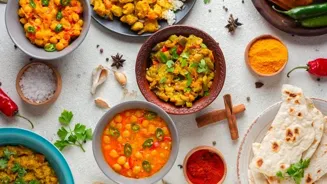Dive into the world of Indian Thalis: A culinary journey embracing diversity and tradition. Explore more!
India, a land of vibrant cultures and traditions, offers a kaleidoscope of culinary experiences
that tantalize the taste buds and nourish the soul. Among these, the Indian Thali stands out as a remarkable representation of the country's diverse food heritage.
A Thali, meaning "plate" in Hindi, is not just a meal; it's a holistic culinary journey that showcases the unique flavors, textures, and aromas of a particular region or community.
Imagine a symphony of dishes, each playing its distinct note, harmonizing to create a complete and satisfying gastronomic experience.
From the snow-capped Himalayas to the sun-kissed coasts, the Thali takes on different forms, reflecting the availability of local ingredients, the influence of historical events, and the evolution of culinary practices.
The Thali: A harmonious blend of flavors for well-being
The concept of the Thali is deeply rooted in the Indian tradition of mindful eating. It's about balance – a perfect equilibrium of sweet, sour, salty, bitter, and pungent flavors. This balance is not merely for taste; it's believed to be essential for promoting digestion and overall well-being.
A typical Thali comprises an assortment of dishes arranged artfully around a central serving of rice or roti (Indian flatbread). These dishes often include a lentil-based preparation (dal), a vegetable curry (sabzi), yogurt (dahi), pickles (achar), chutney, and a sweet dish (mithai).
The Thali is usually served on a round platter, traditionally made of stainless steel or brass, reflecting the practicality and cultural significance of these metals in Indian households.
Regional Thalis showcase diverse flavors and traditions in India
The regional variations in Thalis are truly mesmerizing. In North India, you might find the Rajasthani Thali, known for its rich and flavorful dishes like dal baati churma (lentil and wheat dumplings served with a sweet crumble) and gatte ki sabzi (gram flour dumplings in yogurt-based gravy).
The Gujarati Thali, on the other hand, is known for its subtle sweetness and use of ingredients like lentils, yogurt, and vegetables. The South Indian Thali, especially the Andhra Thali, packs a fiery punch with its use of chilies and spices.
The Kerala Sadya, served during the Onam festival, is a vegetarian feast served on a banana leaf, boasting an array of curries, pickles, and pappadums. Each region's Thali tells a story, reflecting its unique identity and cultural nuances.
Maharashtrian Thali delights with Pithla Bhakri & Bharli Vangi
The Maharashtrian Thali is unique and delicious. Typically, you’ll find a mix of dishes; like Pithla Bhakri, you will love the simple charm of this Thali. Pithla is made from Besan (gram flour) and Bhakri is a flatbread made from Jowar or Bajra or even Rice flour.
It is considered a staple in Maharashtrian households. Next, you may find Bharli Vangi, It is one of the most popular vegetarian dishes from Maharashtra, in this dish the small brinjals are stuffed with a spicy mixture of coconut, peanuts, sesame seeds, and spices.
It is then slowly cooked until the brinjals are tender and the flavors are blended together, giving the dish a very good taste.
Traditional Bengali Thali features Aloo Posto and Shukto, loved for unique flavors
The Bengali Thali is a very attractive offering for someone who loves to explore different flavors, they will definitely love this. One of the main parts of this Thali will be Aloo Posto, it is a classic Bengali dish made with potatoes and poppy seeds.
The potatoes are cooked in a creamy poppy seed paste along with green chilies and other spices. It is one of the most loved dishes in West Bengal.
Another loved dish is Shukto, it is a very healthy dish with a medley of vegetables like bitter gourd, drumsticks, green papaya, potatoes, and eggplant cooked and blended in a milky white gravy. It is a unique dish that is loved by everyone in West Bengal.
Thematic Thalis add modern twist to traditional Indian dining
Beyond the regional variations, theme-based Thalis are also gaining popularity. These Thalis focus on specific ingredients, cooking styles, or dietary requirements.
For instance, you might find a millet Thali showcasing the versatility of millets in Indian cuisine, or a sattvic Thali featuring vegetarian dishes prepared without onion and garlic, adhering to Ayurvedic principles.
These innovative Thalis cater to the evolving tastes and preferences of modern diners, while still preserving the essence of the traditional Thali experience.
The Thali is more than just a meal; it's a celebration of Indian culture, a testament to the country's culinary ingenuity, and a reminder of the importance of mindful eating.
AI Generated Content. Glance/InMobi shall have no liability for the content